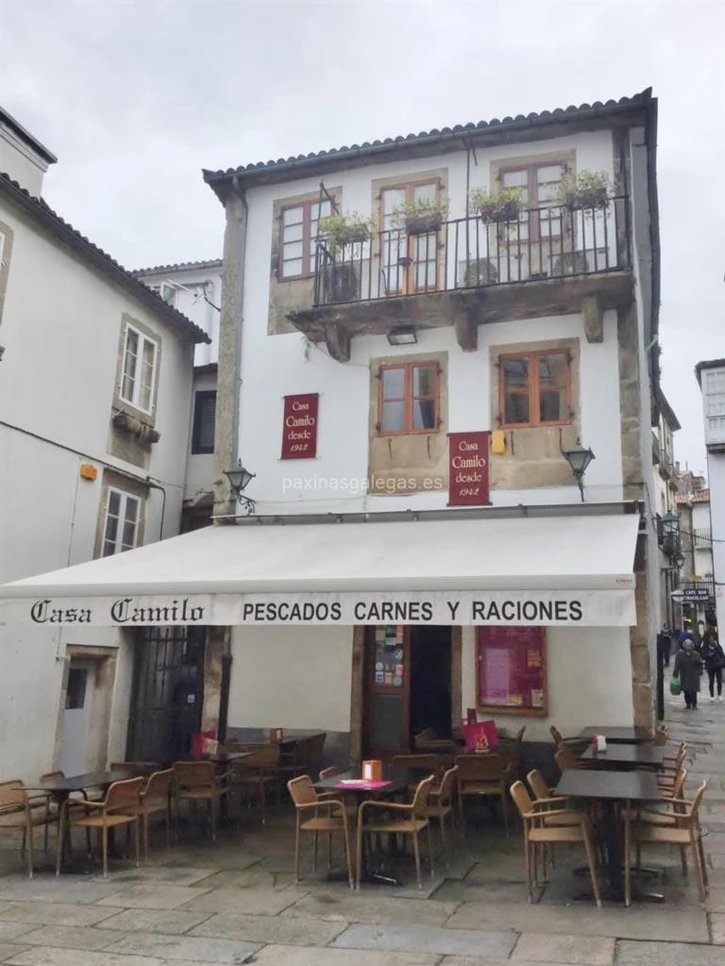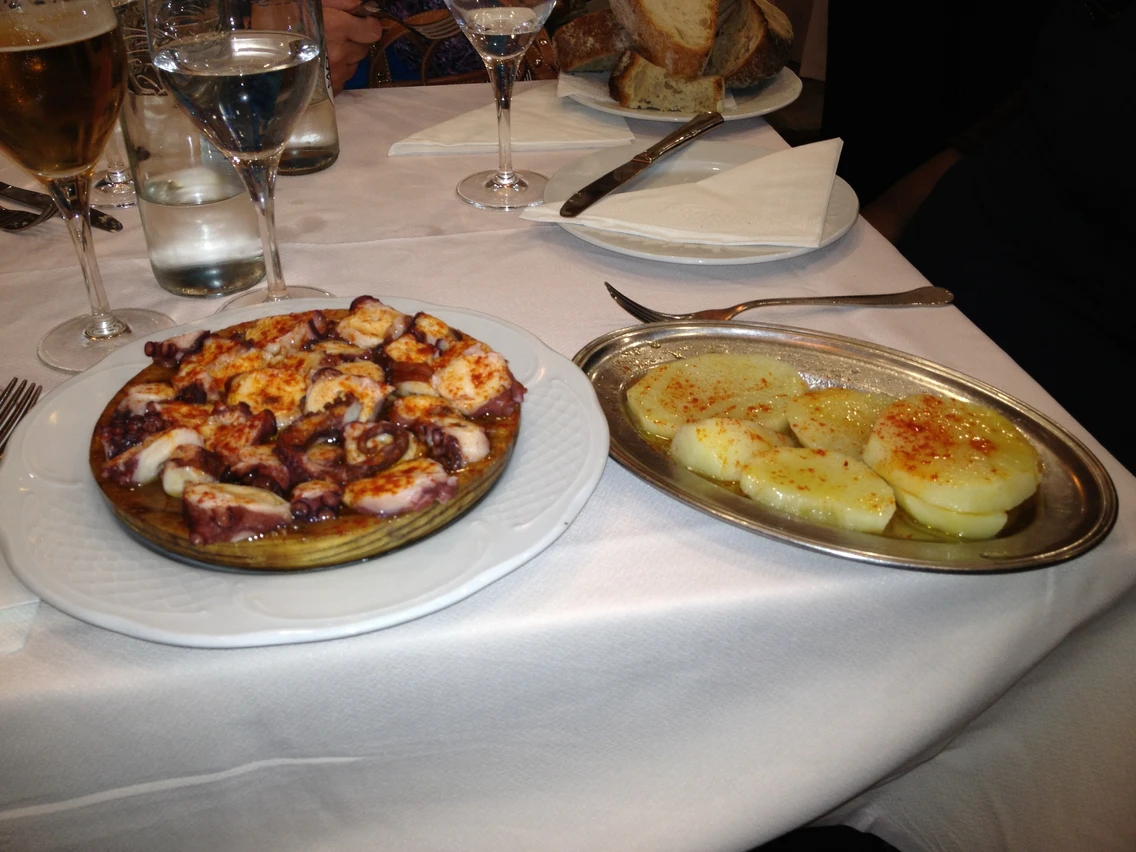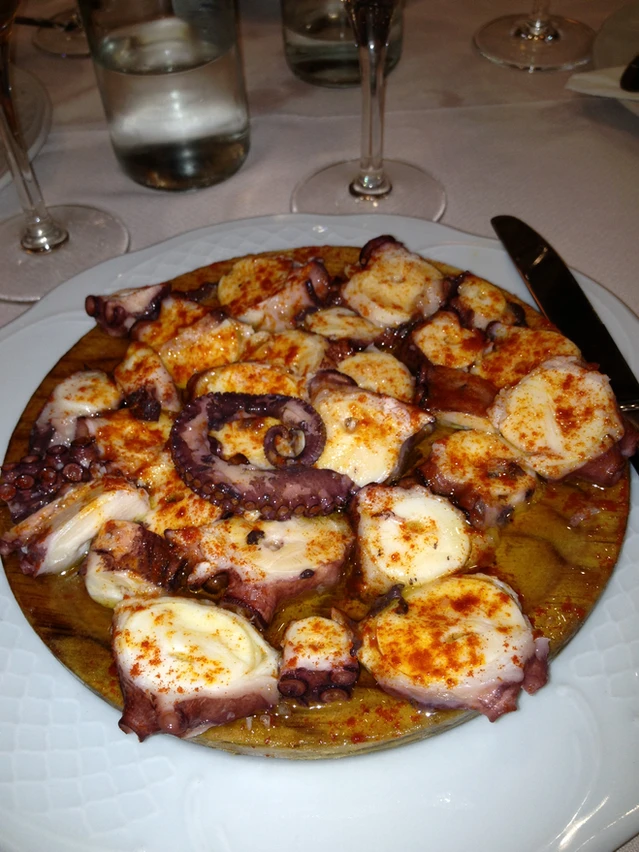After covering the four corners of the shrine, we decided it was time to have dinner. Galicia is known for its fine seafood dishes, most notably, the local octopus delicacy, pulpo a la feira.
We walked a few blocks away from the cathedral, where there was a myriad of restaurants, bars, and cafes catering to the tourist crowd. We assigned one of our travel amigas to pick a place. I was excited to try the pulpo, so I asked her to choose one that serves this dish. She spotted an open-style bar that displayed a picture of the pulpo dish and a delectable tapas selection on its window menu.
As we entered, we saw some of our tour mates (half of Ms. Lady Ringleader’s group) already seated in three long tables, combined to form one banquet table. We noticed they already had their drinks and about four huge plates of appetizers just arrived, so we just waved to them and sat at a separate table in the other corner. As we were reviewing the menu, we couldn’t help but overhear the only server taking the orders from the big table. And boy, was it not going well! There was certainly some misunderstanding, partly because of the language barrier (English spoken with a strong Filipino accent on one side, and limited English with a Galician accent on the other) and the fact that the group was asking too many questions, talking to the server at the same time, and changing their minds every two seconds. We felt so sorry for the server, but we didn't really want to meddle, lest we create more confusion.
My amigas and I threw each other an understanding look that said, “Should we get out of here before this turns into an Alcobaça Episode Part 2?" (Please see the "Lunch Renegades in Alcobaça" story for reference.) In two seconds, we were out of there. I think we told the server and our tour mates that we forgot something at church or something like that.
We found a small restaurant-pub nearby in a quaint old building with a terrace on the upper floor. We went in and inquired about the menu. As soon as we confirmed they had the pulpo, we requested a table. It turned out to be a much better choice than the restaurant we just left.
On its walls were culinary certificates and awards, as well as photos of celebrity patrons. We realized that we were in one of the most popular and most-trusted establishments in Santiago - Casa Camilo. Apparently, since 1942, this restaurant has been renowned for its Galician dishes and excellent customer service. We would never have known this because there were no loud advertisements outside. Most of the customers were locals, or tourists who took the effort to consult the locals…or us, who were lucky to have stumbled upon this place by chance.
One of my amigas ordered a stuffed fried sardine dish that came with potatoes and bread. The other one got a variety of the Empanada Gallega, which is a puffed pastry filled with meat, veggies, and spices. She chose the one with cod and raisins. One just wanted a light fare of seafood chowder. We all ordered some local beer, and of course, I had my pulpo.
The pulpo a la feira is a must-have when in Galicia. It is one of, if not the most popular local specialties. It is made from fresh octopus caught in the Atlantic shores of Galicia, beaten and boiled in a copper pot until nice and tender, snipped into medallions, sprinkled with coarse salt and paprika, drizzled with olive oil, and served on a wooden plate with cachelos (boiled potatoes).
Though my tour mates thought I was eating something exotic, octopus for me is not a stranger at the table. I have been eating octopus sushi and sashimi for most of my adult years. This dish, however, offered brand new flavours to my taste buds. The pimiento picante, as the paprika is called in this region, was deliciously spicy and quite different from the paprika taste I am used to back home, and the olive oil was simply the perfect coating for the al dente texture of the octopus. I also had a bite of my amiga’s empanada. It was crusty on the outside, tender on the inside, and bursting with seafood goodness.
We skipped dessert as we were quite full. Instead, we navigated the shopping streets and window-shopped. I found a souvenir shirt with a cartoonish print of a little boy sporting an impish smile, his tummy bulging out of a small shirt he has clearly outgrown, and carrying a huge backpack against the background of the cathedral. I bought it for my son. That little boy reminded me of him. I suddenly missed him.
There were also lots of souvenir items shaped like scallops – magnets, soaps, Christmas tree ornaments, toys, cakes, chocolates, and candies. But my interest was piqued by the numerous “witch” souvenirs sold alongside those with Santiago themes.
What has a witch got to do with the camino? I asked one of the shopkeepers and she briefly told me that this legend stems from pre-Christian pagan roots. Without giving much detail, she just said that these flying witches or meigas are considered good and they are supposed to bring good luck. It’s quite fascinating because I had never seen witches, broomsticks, and pagan amulets displayed right next to religious items in every shop and in every sidewalk stall. Quite an irony, I must say!
And because this intrigued me, I read about this a little bit after I left Santiago. Apparently, aside from the Santiago de Compostela Shrine, Galicia is also known as the “Land of the Witches.” But these are not the evil witches of Halloween lore. Rather, they are symbolic of the women from the ancient Celtic tribes who played very important roles in their society as healers and advisors. Even after Christianity has reached this region, the Church couldn’t completely change this ancient culture.
Hence, some people practice Catholicism fervently, but still consult local witches, to cover all their spiritual bases, so to speak. It reminded me of my own country, where the indigenous folk religion includes animism and folk healing. When the Spaniards came, the local shamans replaced their native prayers and spells with Catholic-inspired prayers (called oraciones). Up to this day, there are people in my home country who go to Christian churches, but still consult folk healers and follow their healing methods.
This explained a lot. When I first set foot in Galicia, I did not feel the typical Spanish vibe that conjures images of warm days, flamenco dances, paella feasts, bull fights, and loud, "Oles!" Rather, Galicia appeared somber and melancholic when compared to its other Spanish sisters. It felt more subdued, even a bit dismal, just like the misty and grey weather in this part of the Atlantic.
Learning that this region has strong Celtic roots gave me that “aha-that-is why” moment. Suddenly, the bagpipe music, the Celtic folklore, and the more conservative and formal demeanor of its people made more sense.
We had a few more minutes left before we meet our Tour Director and tour mates at the parking lot, but because our feet were getting a little sore, we decided to just sit along the sidewalk and munch on some sweet treats.
We heard about the Tarta de Santiago (St. James Cake), obviously named in honour of St. James. It’s a small, dense cake made of ground almonds, eggs, sugar, and sprinkled with confectionery sugar over a reverse stencil of the cross of St. James. It’s a typical pastry with a slight lemon flavor and a hint of sweet wine. And by sheer luck, there was a bakery nearby that served this. We each had a small slice. It was the best way to end our afternoon.
Photo Credits:
carlosherrero.com, Luis Calvo, toursgratis.com, letstalkmadrid.com, travelingboy.com, whitakerwire.wordpress.com, caminoenbici.com, galletasparamatilde.com































留言